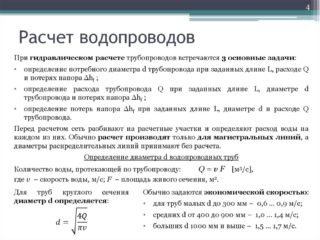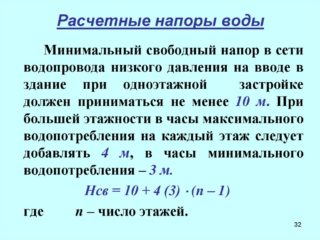Hydraulic calculation of a water supply system - a set of calculations performed at the design stage of a building (multi-storey building, cottage). The role of this type of work is very important - an incorrectly designed water supply system will not function normally. This can be expressed in a weak water pressure on the upper floors of high-rise buildings and in frequent breakthroughs of basement communications due to high input pressure.
Objectives of performing the hydraulic calculation of water supply networks
- calculation of the maximum water consumption in individual sections of the water supply system;
- determination of the speed of movement of water in pipes;
- calculation of the internal diameter of pipes for the installation of various sections of the water supply network;
- calculation of the loss of water pressure when it is supplied from the main pipeline to a certain height;
- determination of the capacity of pumping equipment and the feasibility of its use, taking into account the calculations made.
Calculations are carried out on the basis of data and methods SNiP 2.04.01-85 "Internal water supply and sewerage of buildings".
Options for the hydraulic calculation of water supply networks
Depending on the goals, two types of hydraulic calculation of water supply networks are distinguished - design and calibration (commissioning).
Project
This type of hydraulic calculation is performed when designing a building's water supply system. With its help, the type of pipelines is determined for different sections of the network, the flow rate in them.
In addition to calculations, this type of calculation includes a schematic arrangement of the elements of the internal water supply system - the input node, basement communications, risers, water intake nodes.
Verification
The main goals of this type of hydraulic calculation is to determine the distribution of flows in the water supply system, to calculate the pressure of sources with pre-calculated internal diameters of pipes and water withdrawals at nodal points.
The results of the verification calculation are:
- water consumption and head losses in all sections of the water supply system;
- the volume of water supply from the source (main water supply, water tower or counter-reservoir);
- piezometric heads at various points of draw-off.
All the values obtained as a result of this calculation are used to design the location of the draw-off points - plumbing fixtures - inside the projected building.
Accurate and fairly quick commissioning calculation of water supply networks of various configurations (from a simple dead-end water supply system to a more complex ring system) can be performed using the programs: "HydroModel", "Smart Water", "WaterSupply", "Hydraulic calculation of the pipeline".
Hydraulic calculation procedure
- Determination of the number of draw-off points - for this, according to the standard building plan, the number of washbasins, baths, and toilet bowls in the building is determined.
- Drawing up a schematic image (axonometric diagram) of the internal water supply network - manually or using special software, a diagram of the location of the water supply pipes and the plumbing fixtures connected to them is drawn up. At the same time, for the convenience of further work, each hot and cold water supply pipeline is marked with different colors (red and blue, respectively).
- Splitting the water supply network into separate calculated horizontal and vertical sections, consisting of pipelines and water-folding units. The boundaries of each section are valves and plumbing fixtures.
- Calculation of the probability of simultaneous switching on of all water-folding units of the calculated section (P) - the calculation of the value of this value is carried out according to the following formula:
P = Q max.inlet × U / Qapp. × N × 3600;
WhereQ max water –Water consumption during hours with maximum water consumption, l / h per 1 inhabitant;
U - the number of residents who are provided with water for communications and water-folding units of the settlement area, people;
Qapp. - standard flow rate through the water intake unit averaging 0.18 l / s;
N - the number of water draw-off nodes (plumbing fixtures) included in the calculated area, pcs;
3600 Is the coefficient used to convert liters per hour to liters per second.
- Determination of the maximum second water consumption by the pipeline and water intake units of the calculated area according to the formula:
Q max.flow in = 5 × Q in.prib × a; l / s
Where Q c.prib - the total standard flow through the water intake nodes of the site;
a - dimensionless quantity. Its value is found according to special tables in SNiP 2.04.01-85.
- Selection of the optimal internal diameter of the pipeline is selected taking into account the recommendations for use and the economic feasibility of using in these conditions.
- Calculation of water speed - calculated according to special methodological manuals, based on the inner diameter of the selected pipeline.
- Calculation of head loss (Hl) according to the formula:
Hl = L × i × (1 + Kl); m water column,
Where L - the length of the calculated section, m;
i - specific pressure losses during friction of water against the inner walls of the pipeline, this value is measured in millimeters of water column / meter of the pipeline;
Kl - the correction factor, when designing residential apartment buildings and cottages, its value is 0.3.
- For buildings with 2 or more floors, the hydraulic calculation of the required pressure (Htr) of the water supply in the place of its connection to the external main pipeline is carried out according to the following formula:
Htr = 10 + (n-1) × 4,
Where n - number of floors;
4 - the head required to raise water for each floor located above the first, m.
- The actual required head at the injection point (Nf) is found by summing the calculated input head (Htr) with head losses in the calculated sections (Hl):
Нф = Htr + Нl calc. Unit 1 + Нl calc. Unit 2 + Нl calc. Unit 3 + Нl calc. Unit 4 + Нl calc. Unit n
The results of this calculation are recorded in a summary table.
The head of 10 meters of water is equal to the pressure in the water mains equal to 1 atmosphere (1 Bar).
Example of calculating cold water supply
Initial data:
The building is a 2-storey building with a basement floor, one vertical riser from the basement to the top of -6 m, 5 points of water intake (kitchen sink, bath and washbasin mixer, toilet bowl, - on the first floor; toilet bowl and shower stall mixer - on the second floor). A family of 6 lives in the house.
Calculation sequence:
- The projected internal water supply system is divided into 2 calculated areas - the first and second floors. The length of the communications of the first section is 5 m, the vertical riser and horizontal communications of the second section are 5.5 m.
- Using the SNiP tabular data, the probability of the simultaneous inclusion of all water-folding units for the first and second calculated sections is calculated:
P1 = 15.6 × 6 / (0.1 + 0.18 + 1.4) × 3600 = 0.015;
P2 = 15.6 × 6 / (1.4 + 0.18) × 3600 = 0.016.
- The maximum consumption of these sections, taking into account the corresponding values of the coefficient found from the tables a will be equal to:
Q max.flow water1 = 5 × Q v.prib × a = 5 × 0.18 × 0.265 = 0.24 l / s;
Qmax flow water2 = 5 × Qw.app. × a = 5 × 0.18 × 0.241 = 0.22 l / s
- Taking into account the obtained values of water consumption, the internal water supply system is designed from a simple polypropylene pipe with a diameter of 25 mm (horizontal branches from the riser) and 32 mm (vertical riser).
- Based on the values of the length of the first and second calculated section, the value of the coefficient i and Kl (for such conditions, they are equal to 0.083 and 0.3, respectively) the pressure loss in the first and second calculated sections will be equal to:
Нl area 1 = L1 × i × (1 + Kl) = 5 × 0.083 × 1.3 = 0.54 m.water. pillar;
Нl area 2 = L1 × i × (1 + Kl) = 5.5 × 0.083 × 1.3 = 0.59 m.water. pillar.
The total head loss in the two calculated areas will be equal to 1.14 water column or 0.114 atmosphere.
- The required head at the point of entry for such a building will be equal to:
Htr = 10 + (2-1) × 4 = 14 meters of water column or 1.4 atmospheres
- The actual required head at the point of entry for this cottage will be:
Нф = Нтр + Нl calc. Unit 1 + Нl calc. Unit 2 = 14 + 1.14 = 15.14 meters of water column or 1.5 atmosphere
Thanks to the calculation made, the owner of the house at the design stage, taking into account the pressure of the main water pipeline of his settlement, can plan a certain scheme of the internal water supply network.











